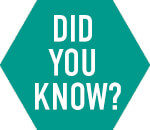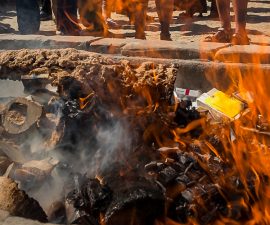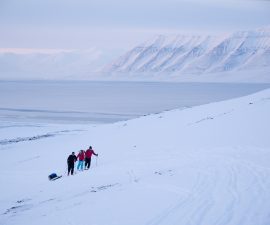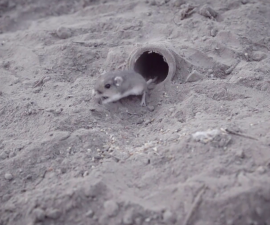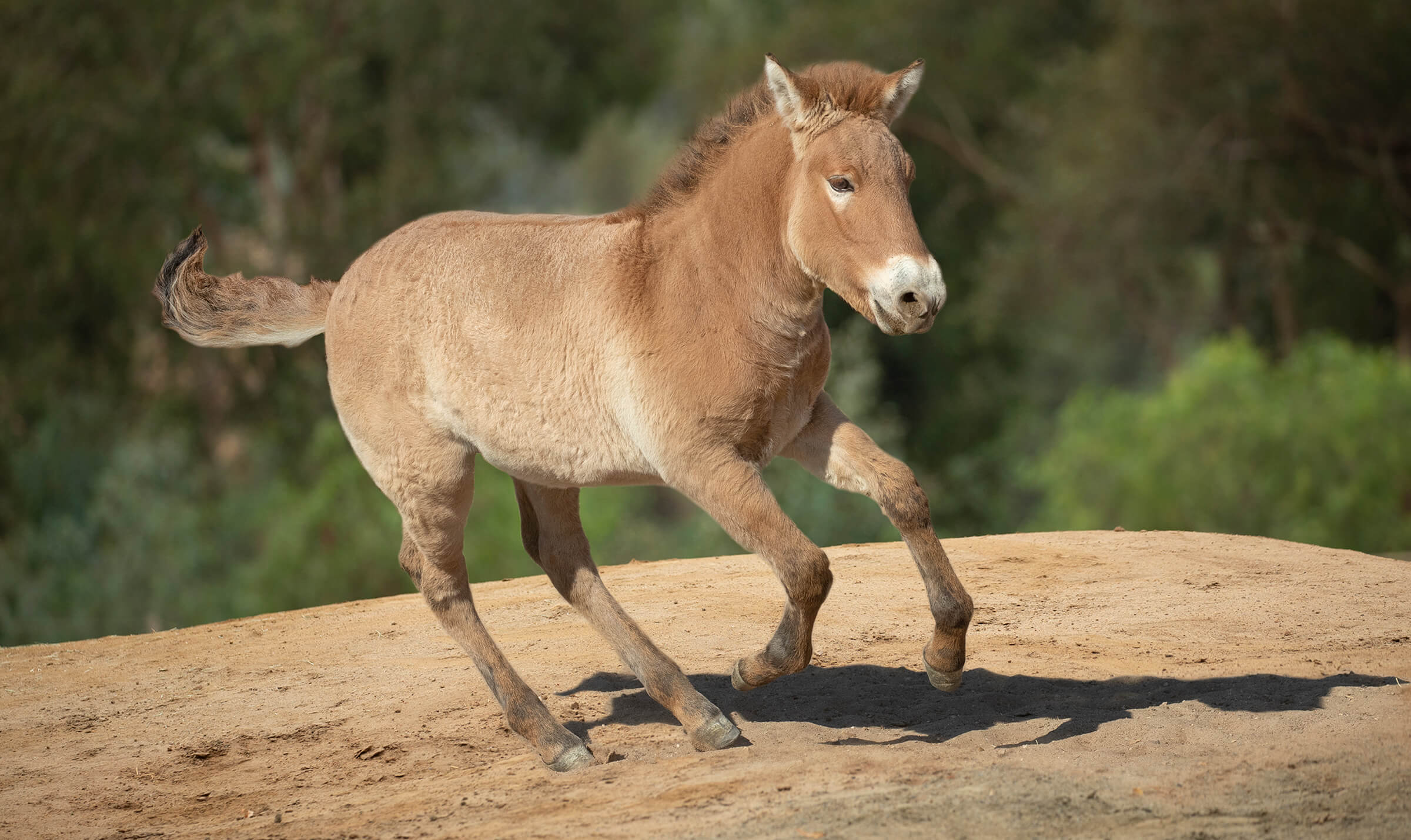
The Last Wild Horse
The Birth of a Clone Named Kurt Brings New Hope for Endangered Przewalski’s Horses
BY Eston Ellis
Photography by Ken Bohn
While many feral domestic horses are called “wild,” there is only one true wild horse species left on earth: the Przewalski’s horse Equus ferus przewalskii, which first became known to Western science in 1881. Most scientists believe that Przewalski’s horses and domestic horses are survivors of two separate lineages that diverged before horses were first domesticated.
But while domestic horses are numerous and are found worldwide, Przewalski’s horses are categorized as Endangered on the International Union for Conservation of Nature Red List of Threatened Species. They became extinct in the wild by the 1980s, and efforts to release Przewalski’s horses bred in managed care into reserves in their native Mongolia began in the 1990s. Today, fewer than 2,000 are believed to exist worldwide—in managed care and in several reintroduction areas in Mongolia, China, Hungary, Kazakhstan, Russia, and Ukraine. The species faces a serious threat from inbreeding, because all Przewalski’s horses that have been born through current breeding programs are descended from just 12 individuals that were in human care at the beginning of the 20th century.
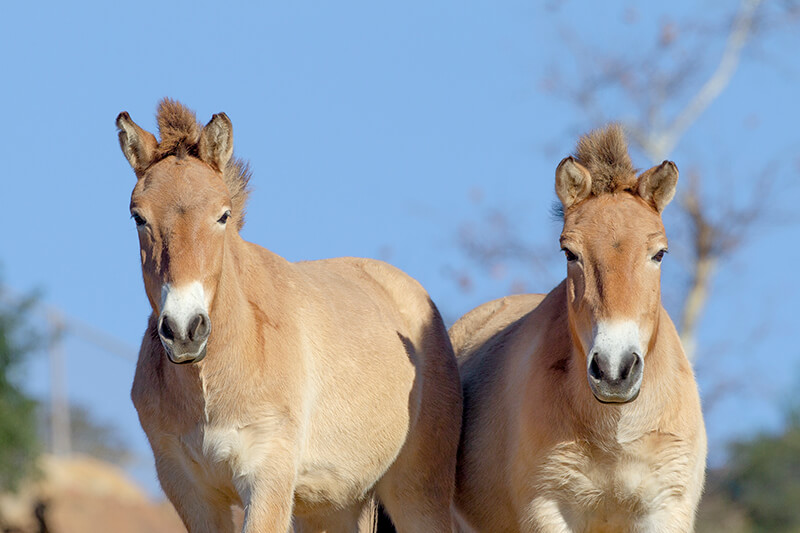
TRULY WILD
Przewalski’s horses are stockier, stouter, and have bulkier necks than domestic horses. They typically have buckskin coloration, spiky manes, white muzzles, dark legs, and dark-rimmed ears and nostrils.
Fortunately for the species, and thanks to the efforts of San Diego Zoo Global’s Frozen Zoo in preserving genetic material of more than 400 Przewalski’s horses, and new advances in reproductive technology, there is a way forward for this species. When the world’s first successful Przewalski’s horse clone was born on August 6, 2020, it made headlines around the world. The new colt was born to a domestic horse mare surrogate from genetic material that had been cryopreserved in San Diego Zoo Global’s Frozen Zoo since 1980—from a stallion whose ancestry strongly reflects two Przewalski’s horses brought from the wild to Europe in 1901. The cloned colt was named “Kurt,” in honor of the late Dr. Kurt Benirschke, whose groundbreaking efforts launched the Frozen Zoo in 1975.
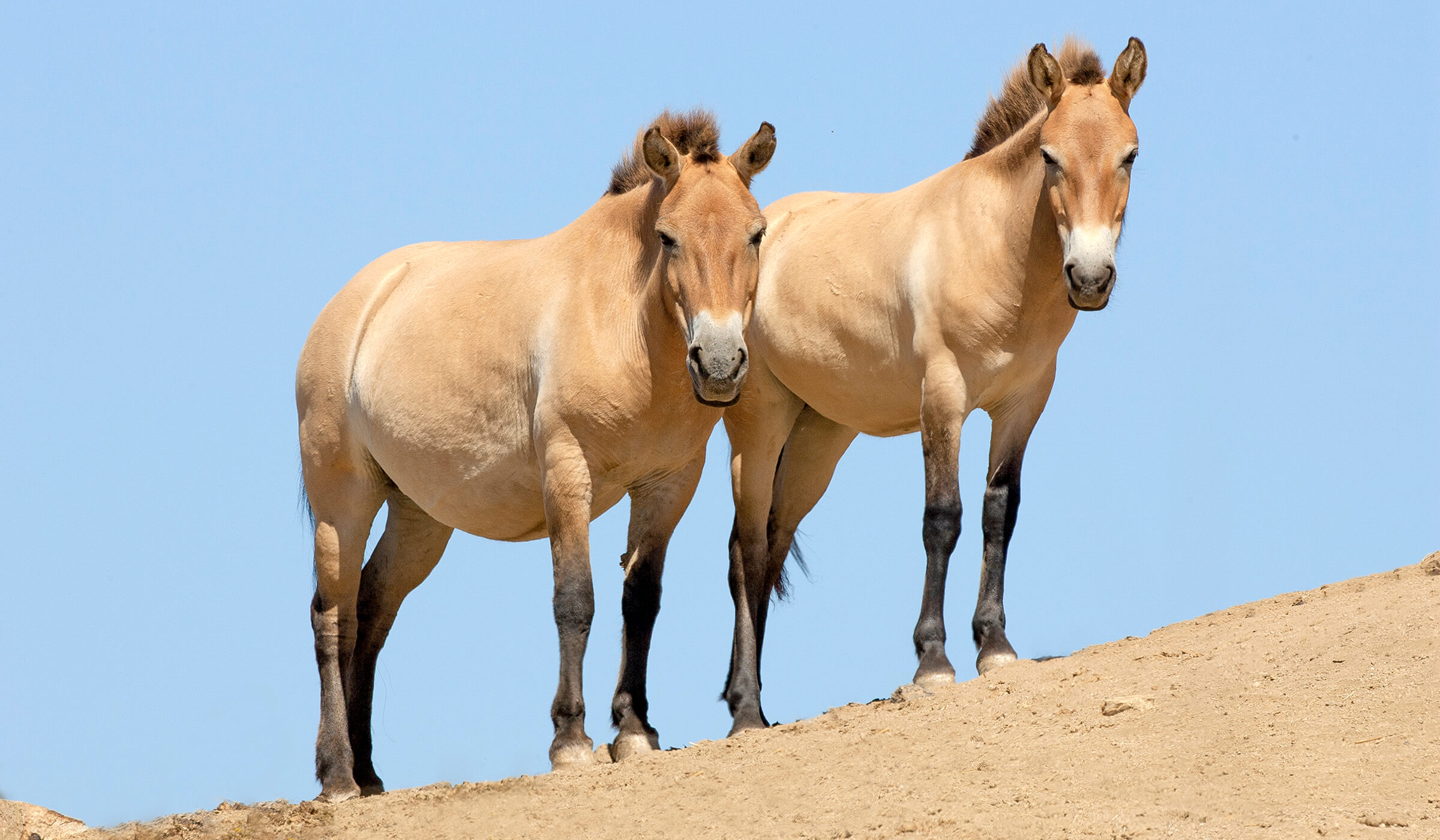
A Distinctive Species
Przewalski’s horses are native to the steppe, a sparse grassland habitat that once encompassed large areas of Asia and extended all the way to what is now Spain and Portugal. However, after the last Ice Age, much of the steppe was replaced by forests, and Przewalski’s horse populations became mostly limited to areas in Mongolia, southern Russia, and Poland. In Mongolia, these wild horses are called “takhi,” and folk legends depict them as the riding mounts of the gods.
A Przewalski’s horse measures 4 to 4.6 feet tall at the shoulder and weighs 440 to 660 pounds. In contrast, a domestic Arabian horse is about 5 feet tall and weighs 800 to 1,000 pounds. Stockier, more stout, and with bulkier necks in comparison to most domestic horses, Przewalski’s horses are typically buckskin in coloration, with a light-colored belly, a light-to-white muzzle, a black, spiky (erect) mane like a zebra, and—usually—dark legs. A dark stripe runs down their back from the withers to the base of their long, dark tail. Unlike domestic horses, they don’t have a forelock—a lock of hair on the forehead. Their large, pony-like head is rectangular, and their ears and nostrils are darkly rimmed. In winter, they grow thick coats to stay warm in the extreme cold temperatures of their native habitat.
Scientists have discovered that Przewalski’s horses have 66 chromosomes, while domestic horses carry only 64. When the two species have interbred, they have produced offspring that have 65 chromosomes.
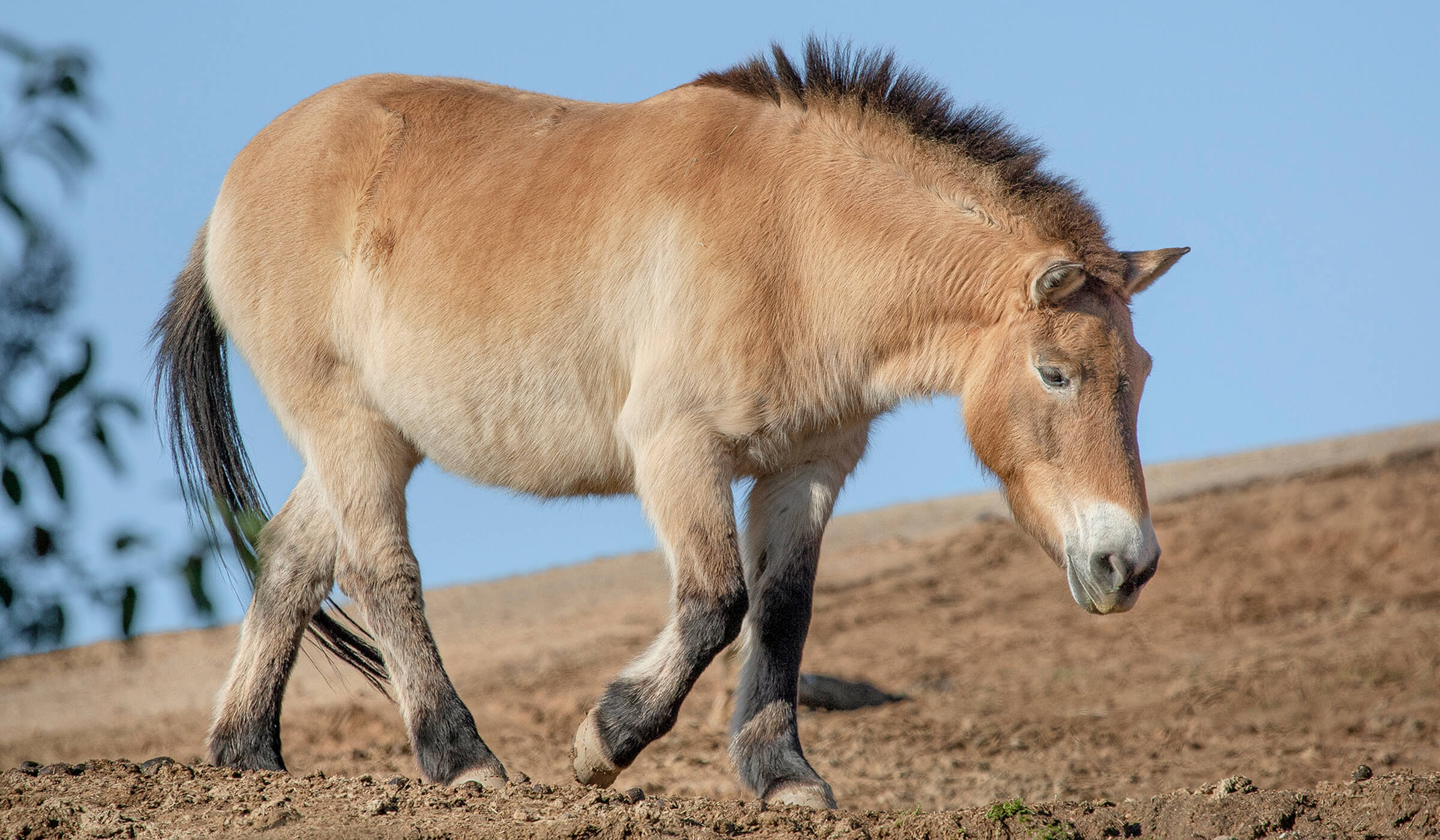
Wild History
While this wild horse has been known in Mongolia for centuries, and has even been depicted in ancient rock drawings, the western world “discovered” the Przewalski’s horse in 1881 when it was brought to the attention of western scientists by Nikolay Przhevalsky, a Russian imperial geographer known for his exploration of Central and East Asia. The skull and hide of a dead specimen was brought to a museum in St. Petersburg, in Czarist Russia, and the species eventually became known as Przewalski’s horse—using a Polish spelling of Przhevalsky’s name. In Europe, news of the wild horse sparked a flurry of interest, and several expeditions were mounted to bring back live foals for exotic animal collections. By 1902, a total of 52 Przewalski’s horse foals had been collected for wealthy private collectors and zoos.
However, by this time, few Przewalski’s horses remained in their native habitats, and efforts to breed the horses in human care were mostly unsuccessful. A large group of Przewalski’s horses in southern Russia was killed during World War II, and after the war only 31 were left in human care. That situation prompted stepped-up efforts to successfully breed the species, creation of a Przewalski’s horse studbook, and interest in establishing herds at zoos to boost the species’ population.
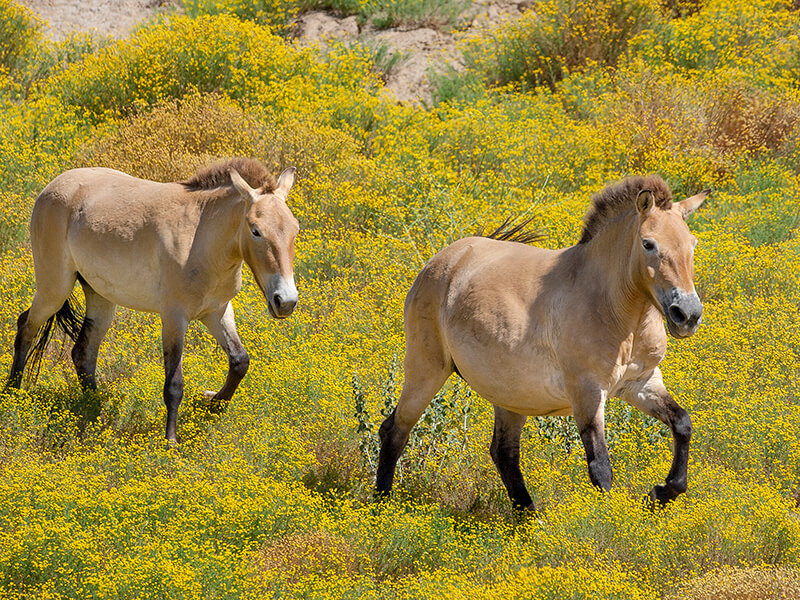
ENDEARING AND ENDANGERED
Fewer than 2,000 Przewalski’s horses are believed to exist worldwide, in managed care and in reintroduction sites.
In 1966, Przewalski’s horses arrived to start a new herd at the San Diego Zoo—a male and two females—and foals were born at the Zoo in 1969 and 1970. A herd would later be established at the Safari Park. The San Diego Zoo’s Center for Reproduction of Endangered Species (CRES) was launched in 1975, and Dr. Kurt Benirschke, working with Oliver Ryder, Ph.D. (who is now director of Conservation Genetics at San Diego Zoo Global), began genetic studies of the Przewalski’s horse population that was in human care at the time. Studies of the prevalent gene pool showed that individuals were being highly inbred, Dr. Ryder said.
“In 1979, the first conference bringing together the breeders of Przewalski’s horses in North America was held here in San Diego,” with horse breeders attending from throughout the nation, Dr. Ryder said. He went on to publish several papers on Przewalski’s horse genetics, and soon the first Species Survival Plan program for Przewalski’s horses was established, to ensure genetic viability of future breeding efforts. “It became clear that this effort in North America was instrumental, but it really needed to happen on a global scale.”

“MOHAWK” MANE
The Przewalski’s horse has a spiky, erect mane, similar to a zebra—and unlike domestic horses, it has no forelock.
Together with partners, San Diego Zoo Global and its Conservation Genetics scientists organized a cooperative breeding program, designed to conserve genetic variation and reduce inbreeding. A historic exchange of Przewalski’s horses between US zoos and the former Soviet Union in 1982 led to collaborative studies that provided information to correct the pedigree record for the species. Today, zoo-based efforts to conserve Przewalski’s horses have grown into a global management program that continues to provide horses for release into wild reserves. More than 150 Przewalski’s horses have been born at the Zoo and Safari Park, and offspring of many of them have contributed to breeding programs at other zoos and to reintroduction projects.
But one problem remained: while efforts to maximize genetic variation in the existing population of Przewalski’s horses have been successful in helping this species recover, the fact remains that these surviving wild horses are descended from a relatively small number of founder individuals. Fortunately, because scientists at San Diego Zoo Global began the Frozen Zoo 45 years ago to preserve genetic material of endangered species, resources now exist to help eliminate this species’ “genetic bottleneck” from a limited gene pool. Genetic material samples from more than 400 Przewalski’s horses—including an individual born as long as 68 years ago—have been preserved in the Frozen Zoo, collected from both living horses and museum specimens around the world.
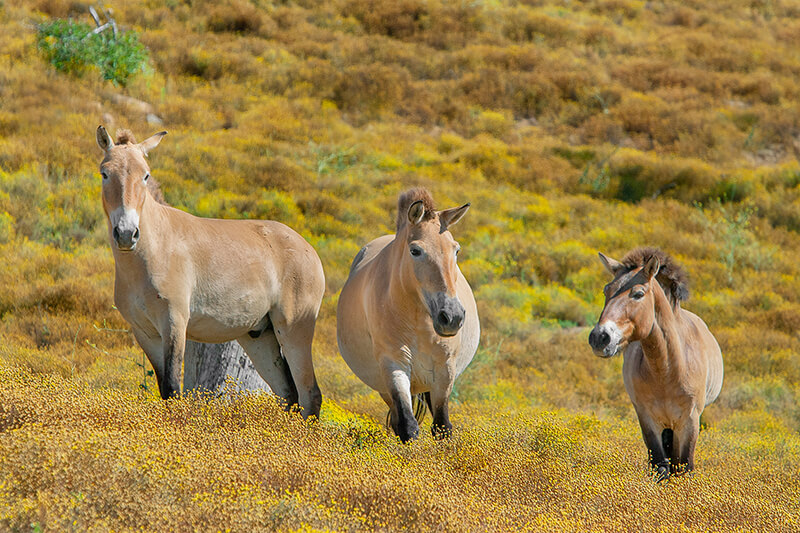
INCREASING THEIR NUMBERS
In ongoing efforts to boost the population of this endangered species, more than 150 Przewalski’s horses have been born at the Zoo and Safari Park to date. Their offspring have contributed to breeding programs at other zoos and to reintroduction projects.
One of those samples of genetic material came from a stallion born in the UK in 1975 at the Zoological Society of London’s Whipsnade Zoo, a facility similar to the Safari Park. That stallion’s strongly reflected ancestry of two Przewalski’s horses brought from the wild to Europe in 1901 and its genetics were underrepresented in the species’ current population. In cooperation with partners at ViaGen Equine, a company with much experience in cloning of domestic horses, and Revive & Restore, a nonprofit conservation organization devoted to enhancing biodiversity through the genetic rescue of endangered species, San Diego Zoo Global provided genetic material for the birth of a cloned colt from that stallion. Cloning technology is already being used regularly for domestic horse and livestock births, but this would be a first for the endangered Przewalski’s horse.

AKA TAKHI
In their native Mongolia, Przewalski’s horses are called “takhi,” and are described in folk legends as riding mounts of the gods.
The starting point for this historic birth was a cultured fibroblast cell line from a skin sample of that stallion, preserved in the Frozen Zoo. An oocyte (or egg cell) was provided by a domestic horse mare. The nucleus of that oocyte was removed and the “donor” stallion’s somatic cell was fused with the oocyte to produce a cloned embryo, which was grown in culture and then implanted in a surrogate mother. The mare carried the clone to term, resulting in the successful birth of Kurt—a Przewalski’s horse carrying all the valuable genetics of a stallion that had died in 1998, born to a domestic horse surrogate mother.
With this contribution, the Frozen Zoo is fulfilling its purpose, Dr. Ryder explained, providing crucial genetic material from individual animals that no longer exist, at a time when it is needed most to save species. “It’s paying off—there are so many things that we have that are special and unique to contribute.” Genetic resources preserved in the Frozen Zoo may also eventually help other endangered species, including the northern white rhino and the black-footed ferret.
“It’s thrilling to see this potential for an unprecedented way, a new approach, a powerful approach to preserve genetic diversity, achieve population sustainability, and contribute to long-term conservation that the technology offers,” Dr. Ryder said.
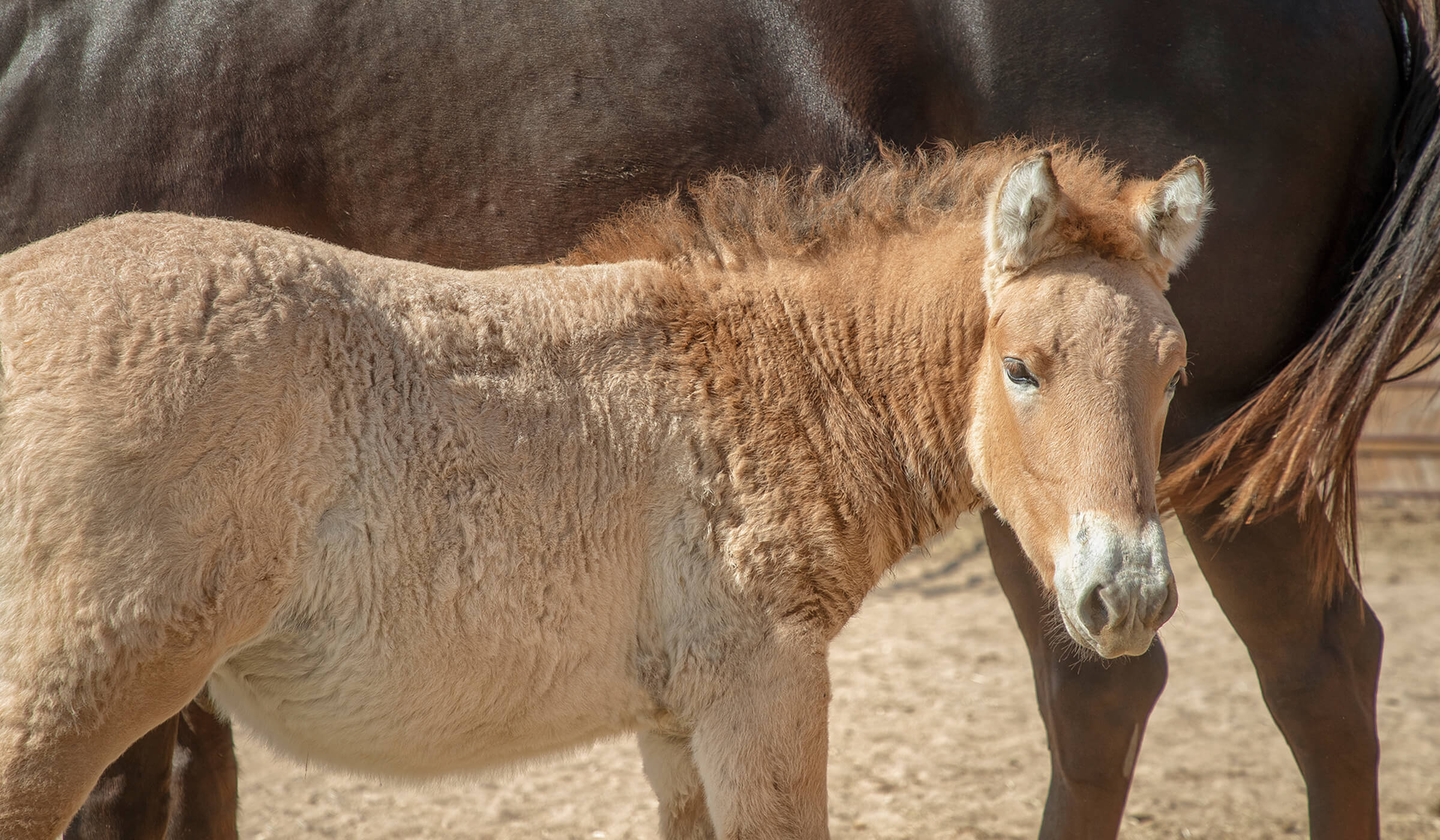
Joining the Herd
Eventually, cloned colt Kurt will be coming to the Safari Park, to join a herd of Przewalski’s horses. Currently, there are 14 Przewalski’s horses at the Safari Park and another 33 living off site. The females and a herd stallion live in the Asian Savanna habitat; and a herd of bachelor males live in an off-view area.
The intention is that Kurt will someday breed, contributing his genetic diversity to help his species survive, Dr. Ryder said. “But first, we want the colt to have a normal socialization and upbringing. We want him to experience interacting with other young horses, and to have a full spectrum of normal behavior as possible.”
Przewalski’s horse stallions typically do not breed until they are at least five years old, Dr. Ryder said. “In the wild, young males affiliate with a bachelor herd when they are around one year old. Until they’re older, and they’ve matured physically and mentally, they don’t have what it takes to be able to challenge a herd stallion to become the leader of a herd of females.”
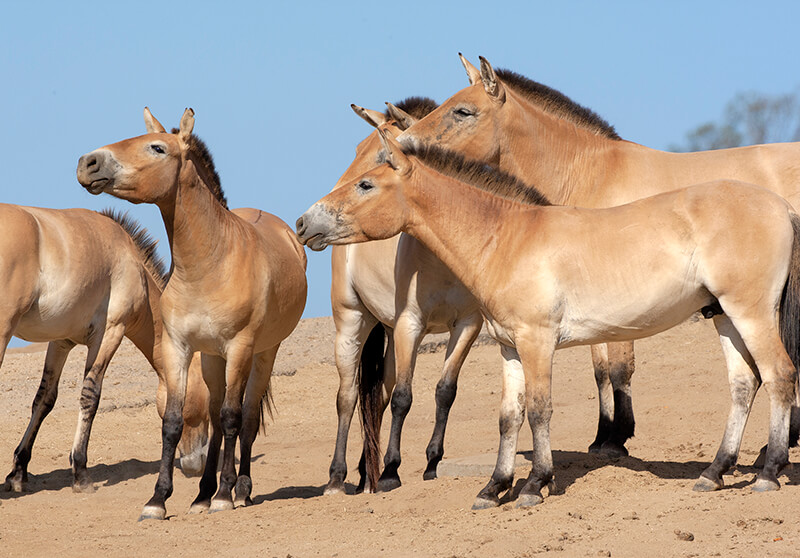
COMING TO THE SAFARI PARK
While Kurt is still being raised by his mom, the colt will eventually join a herd of Przewalski’s horses at the Safari Park, grow to adulthood, and someday sire foals of his own.
While there has been worldwide interest in the birth of Kurt, he’s “one of a cast of many players,” Dr. Ryder explained. “Other cells in the Frozen Zoo that haven’t yet been thawed and turned into animals are also harboring genetic variation that’s been lost.”
More breakthroughs will continue to occur in the years ahead, and preserving genetic diversity of a species through cloning is just one of the tools in our tool kit, he added. “We’ve played a major role in generating new and innovative tools that apply to species conservation. This is a new approach—it’s not in lieu of other more traditional conservation activities. But there are species that are going to be in trouble in the long term, or already are in trouble, and that number is only going to increase. The fact that we bank these cells is extremely useful, and one thing it can do is stimulate global interest in accelerating efforts to bank the kind of material that we’ve been banking.”


